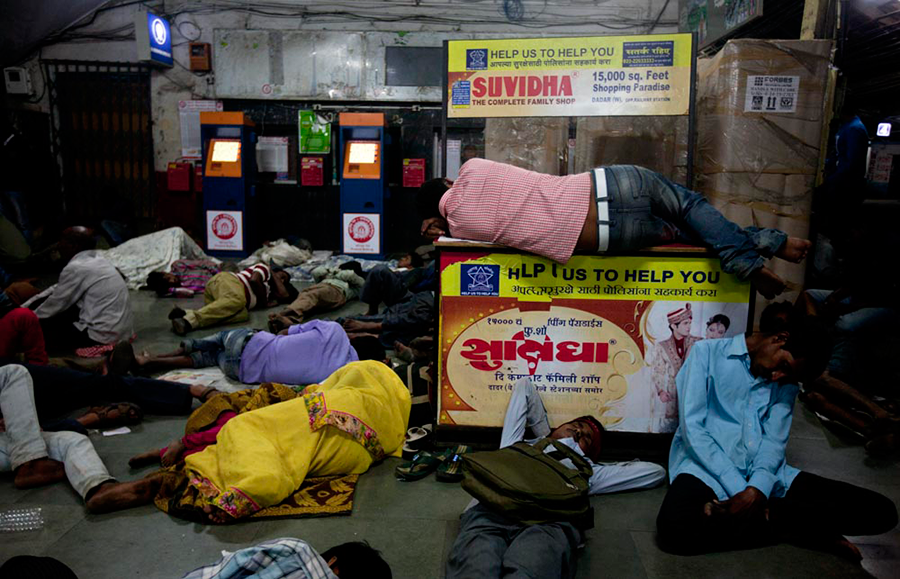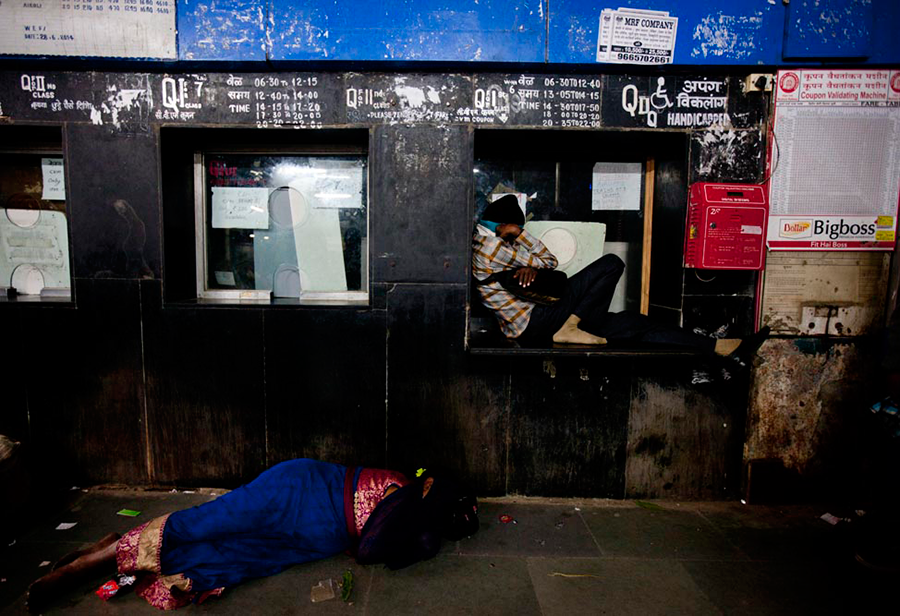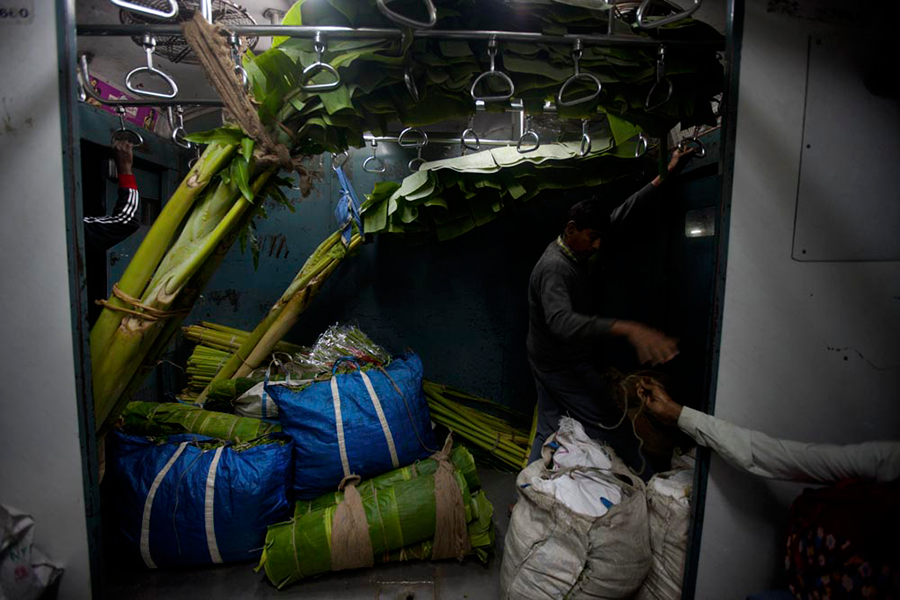Sometimes people were okay with me making pictures, other times they’d stare blankly and once an entire compartment ganged up on me, threatening to throw my gear off the train but eventually mellowed down and complained about the lack of water and electricity in their localities on the northernmost edge of the island city. The late hours began messing with my days, and I soon lost interest, though, every once a while I end up being a traveller on that train.
The last train made me wonder, “What would the first train look like, who are the people travelling on it?” Back in college, I skipped class to watch Indian Ocean playing at a venue nearby. Over the years, I began to appreciate the nuances and technical superiority of Indian Ocean but that evening I found them rather boring. Two hours later, my friends and I were in Nerul, on the outskirts of the city, head-banging to Megadeth covers by bands such as Naked Earth and Killer Tomatoes. The gig went on till 3 in the morning and I remember taking the first train out. We were surrounded by vegetable and flower sellers, fish vendors and some railway officials.
Four nights ago, on a whim, I hopped on the last local and made my way to Virar. For a weekday, the last local was packed to the brim, with no space to stand comfortably or sit. Those who sat on the floor, near the footboard, wouldn’t budge, even if your shoes grazed their trousers. I chose to hop compartments at every station and finally landed up in the luggage section where a few men were swigging McDowells whisky, smoking beedis and playing cards. They told me they were regulars and one of them worked at a liquor shop. For obvious reasons, I chose to not make any photos of the scene. I might make a few once I clock a few more trips and have shared a drink or two with them.
2:30 am The scene at Virar, at the end of the line was surreal – a whole bunch of people asleep near the ticket counters. A policeman told me that these were commuters who had either arrived early from their homes to get the firs train, or had arrived on outstation trains and shuttles and were waiting for a connection to get to their relatives, or homes. One man slept rather comfortably on the granite shelf of the ticket counter, when I realised that my friend, photographer Anushree Fadnavis, wasn't with me any more. She photographs extensively inside second-class ladies compartments. Here’s a link to her series which was featured on an Instagram feed I curate called Katha – dedicated to long-form photo essays crafted using a cellphone camera.

I caught up with Anushree, and we walked around till we went our separate ways. Making pictures for me and a lot of photographers I know is a solitary act and it’s rather uncomfortable to be doing so in a duo or worse, large groups of SLR-wielding folks who at times pop in your frames and make a mess of a photo that was in the making for a while. While one half of the station was catching up on its sleep, the other was prepping for the arrival of the 3.25 am train, the first one.
Flower sellers arrive, armed with stacks of banana leaves and plonk them near the compartments they regularly get in. Koli women with empty fish baskets wait near the ladies compartments. They go all the way to the docks on the city's southern tip to buy fresh catch at wholesale rates, which they sell it for retail prices in the fish markets of northern Virar. Since the train only has three tiny luggage compartments, the vendors have no option but to transport their sacks of fresh flowers in the regular compartments.
The arrival horn of the train wakes up the sleeping commuters and a few of the residents who live near the station. An orderly, well-practiced dance of chaos unfolds – baskets and gunny bags are loaded, and the stacks of banana leaves are tied to poles so that they don’t bend and break. Almost immediately after loading their goods, the vendors fold themselves up in blankets and go to sleep. The station recedes to murmurs of a prayer on everyone’s lips.
Ideally, there should be two separate trains, one for the passengers and a luggage train for the traders.
By the next two stations, the train is packed, much like it is during rush hour in the mornings and evenings. Almost everyone has surrendered to the gentle rocking and is asleep. An argument lights up between two men, one is feeling cold and wants the door closed while the other wants to enjoy the cool draft. “Aaj main nahaakey aaya hoon, isiliye garam lag rela hai,” he says jokingly. I have had a bath today and hence am not feeling too cold. Other unwashed commuters request him to comply. He relinquishes control of the door and it is shut.
I am hopping compartments again, while Anushree has stepped off at her station and is on her way home. Standing at the footboard, I notice a eunuch about to enter my compartment. She touches the vacant space next to my right foot, seeks blessings from the train, and enters inside. It’s business time and she goes about seeking alms from the passengers who give willingly.

As I step into my next compartment, a couple enters. They speak softly to each other, inviting stares. Probably returning home after a party. I step behind, merging with the grey insides of the walls. Sprawled above a group of students heading for a trek, I see a man sleeping on the luggage rack. How in the world did he get there? Abuse is hurled, elbows fly, noses squished and feet trampled as the train arrives at Dadar – home to the city's flower market.
Relatively empty now, we make our way into Churchgate, the last stop, almost 20 minutes later The passengers who aren't asleep go around waking up those who are. The fisherwomen rush to occupy the waiting taxis. Some of them make a dash for the restrooms first. Outside the station, I buy myself a glass of tea and a bread and butter sandwich and sit at the bus stop. It reminds me of the time when five skinny, long-haired were returning from the gig at Nerul. We had to change trains at Dadar but we were hungry and stepped out looking for something to eat. Drenched in tungsten light, the flower market was abuzz. We came across a tea seller who insisted we try his chocolate-flavoured chai, which turned out to be half a bar of Cadbury’s Dairy Milk melted into the tea while it was being made. He was right, the tea was unforgettable indeed.

To shield himself from the cold, a man wraps a handkerchief around his ears while he waits for the train to arrive.

A flower seller offers his friend a piece of rope to tie the end of a roll of banana leaves that has come undone.

Every square inch of space is occupied.
A sleepy commuter looks on as a eunuch enters the compartment.
Take as many photos as you want, but don’t ask me any questions, I have no time.
Two brothers.
Commuters watch as a worker lays tiles on the platform at Lower Parel station.
This post originally appeared on Ritesh Uttamchandani's blog.




















